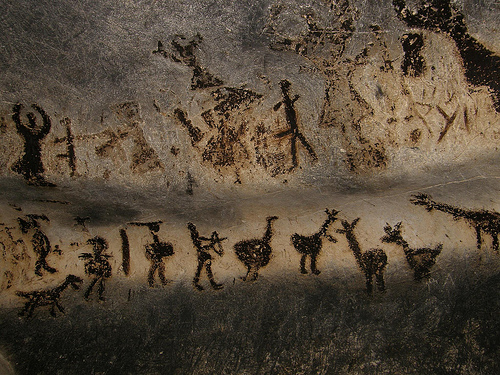Why Storytelling Can Be Anywhere

Cross posted on the Langwitches Blog.
Why can storytelling be anywhere?
Why should storytelling be everywhere?
As you can tell, if you have been reading my blog for a while, I am enthralled with Digital Storytelling (posts tagged with Digital Storytelling). Today, I am thinking NOT only about digital storytelling though. It is about integrating storytelling in any shape and form for teaching and learning.
I am intrigued and fascinated by the resurrection and increase in The Need for Storytelling Skills in the 21st century. In addition to finding a way to conquer information overload, one of the reasons might be the ability to adapt, tweak and make digital storytelling fit with so many different subjects areas and learning objectives.
How is it that storytelling is such a great tool that adapts and molds itself almost fluidly to learning and teaching?

Edutopia’s article by Jennifer New “How to Use Digital Storytelling in the Classroom” states that
Tools and ideas to transform education. Sign up below.
Storytelling is a vital skill with seemingly unlimited applications. Done well, it can have a magical effect — moving, enlightening, or entertaining audiences of any size. We tell stories to woo lovers, calm children, or reassure ourselves. Lawyers rely on the power of storytelling to vividly re-create crimes to juries, archaeologists conjure former civilizations, and teachers make abstract concepts real to their students.
In the introduction chapter of “Digital Storytelling Tools for Educators”, I wrote.
Storytelling is also an ancient form of teaching . Before books, reading and writing became widely spread and available, oral storytelling was the only form the wisdom and knowledge of the people were passed down from elders to children
So storytelling, as a way of teaching and transmitting knowledge, is NOT a new idea. Our ancestors have been doing it for thousands of years.

http://www.flickr.com/photos/klearchos/ / CC BY 2.0
Helen C. Berrett focuses in “Researching and Evaluating Digital Storytelling as a Deep Learning Tool“on how digital storytelling
facilitates the convergence of four student-centered learning strategies: student engagement, reflection for deep learning, project-based learning, and the effective integration of technology into instruction.
Jason Ohler mentions in his book Digital Storytelling in the Classroom: New Media Pathways to Literacy, Learning, and Creativity, that young children know about storytelling BEFORE they come to school. They are familiar with the format, rhythm and sequence. Somehow we stop using their ability to already process and understand that form of transmission of knowledge and abandon storytelling to the “art” of lecturing. He quotes Kieran Egan from the book Teaching as Story Telling: An Alternative Approach to Teaching and Curriculum in the Elementary School :
Kids come to school already understanding the story form. Yet, what they encounter is information in report form, which lacks the rhythm and imagination that makes stories so involving. [...] If we view storytelling as an emerging ability, and seek to nurture it when students enter school, we can tap into communication structures they can already understand.
Read the following passage from “The Housekeeper and the Professor” by Yoki Ogawa, as an example of how storytelling can be used for any subject, facilitate understanding, connect and engage the learner with the content.
The author intertwines masterly math concepts in her narrative.
…”Two is the only even prime. It’s the lead off batter to the infinite team of prime numbers after it”. “That must be awfully lonely,”said Root. “Don’t worry,” said the Professor. “If it gets lonely, it has lots of company with the other even numbers.” [...]
“If numbers never end, then there should always be ore twins, right?” “That makes sense, Root. But when you get to much bigger numbers- a million or ten million–you are venturing into a wasteland where the primes are terribly far apart.” “A wasteland?” “That’s right, a desert. No matter how far you go, you don’t find any. Just sand as far as they eye can see. The sun shines down mercilessly, your throat is parched, your eyes glaze over. Then you think you see one, a prime number at last, and you go running toward it–only to find that it is a mirage, nothing but hot wind. Still, you refuse to give up, staggering on step by step, determined to continue to search…until you see it at last, the oasis of another prime number, a place of rest and cool, clear water…”

As a Word Language teacher, I taught with a method called “TPRS”, Teaching Proficiency through Reading and Storytelling, (originated by Blaine Ray and previously known as Total Physical Response Storytelling). It was the storytelling component, that made the language come alive and “memorable” –literally. Students were able to recall vocabulary and grammar structures more accurately and for longer periods of time than via the traditional method of memorizing long lists of vocabulary words and endless repetition of fill- in- the- blank grammar sentences.
Valeri Marsh writes that “Total Physical Response Storytelling: A Communicative Approach to Language Learning”
provides the critical vehicle–storytelling–for utilizing and expanding vocabulary. High-interest stories contextualize the vocabulary, enabling students to hear and see a story and then to act out, revise, and rewrite.
How are you using storytelling to teach and learn? What subject area or matter are you able to learn/teach better or deeper? What happens to internalizing a concept or content long term? Do you have examples of storytelling that made a difference in understanding where dry facts have or would have failed? I am interested in hearing your experience and field work. Please share.
Why can storytelling be anywhere?
Why should storytelling be everywhere?
